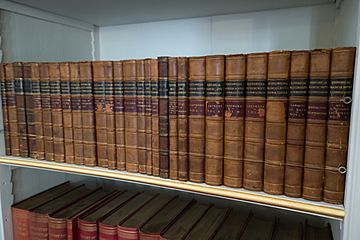Royal Commission on Historical Manuscripts facts for kids

The Royal Commission on Historical Manuscripts (also known as the Historical Manuscripts Commission or HMC) was a special group in the United Kingdom. It was created in 1869 to find and report on old, important documents that were owned by private people or families. These documents were often kept in their homes. The HMC's job was to "find out where these old papers were kept" and to describe what was in them.
The HMC worked until 2003. Then, it joined with the Public Record Office to form The National Archives. Even though the HMC still exists as a legal group, all its work is now done by The National Archives.
Contents
History of the HMC
After a law was passed in 1838 to look after government records, people started thinking about private old papers too. Lord Romilly, who was in charge of public records, helped start the first Royal Commission on Historical Manuscripts. This happened on April 2, 1869.
Lord Romilly was the chairman of the first group of Commissioners. Other important people were also part of this group. In 1876, a new official order made the HMC a permanent group. Its work was expanded even more in 1897 and 1919.
In 1869, four inspectors were hired to find and check these old documents. Over the years, many different people worked as inspectors for the HMC.
For a long time, the HMC worked very closely with the Public Record Office. People even said it was like a part of the Record Office. However, after a new law in 1958, the two groups became more separate. The HMC got new and bigger tasks in 1959.
This time of being independent ended in April 2003. The HMC officially joined with the Public Record Office. Together, they created the new National Archives. Now, the head of The National Archives is also the main Historical Manuscripts Commissioner.
National Register of Archives
The National Register of Archives (NRA) was started by the HMC in 1945. It was created to be a central list for researchers. It tells you what old documents exist and where you can find them. These documents are about British history and are kept in local places or by private owners.
The NRA quickly grew after World War II. It became the main way the HMC collected and shared information about old papers.
The NRA has many lists and catalogs of old document collections. Some were made by the HMC's own staff. But most are copies of lists made by the places where the documents are kept. The Register also has indexes to help you find things by place or person's name.
The paper copies of the Register are now at The National Archives. The indexes, which were first made by hand, are now part of The National Archives' "Discovery" online catalog.
Manorial Documents Register
The Manorial Documents Register (MDR) is a central list of old records from English and Welsh manors. Manors were large estates in the past. This register was first set up in 1926. It was first looked after by the Public Record Office.
In 1959, the HMC took over the job of keeping the MDR. Since 2003, The National Archives has been in charge of it. The paper version of the Register is being put onto computers. The parts that are finished can be found online.
Where the HMC Was Located
Until 1959, the HMC was based inside the Public Record Office building. In December 1959, it moved to its own offices nearby. These offices were called Quality House. People could visit Quality House during office hours to look at the NRA, MDR, and other resources.
Quality House was emptied in late 2003. The HMC's staff and resources then moved to The National Archives building in Kew.
See also
- Record Commission
- Historiography of the United Kingdom


